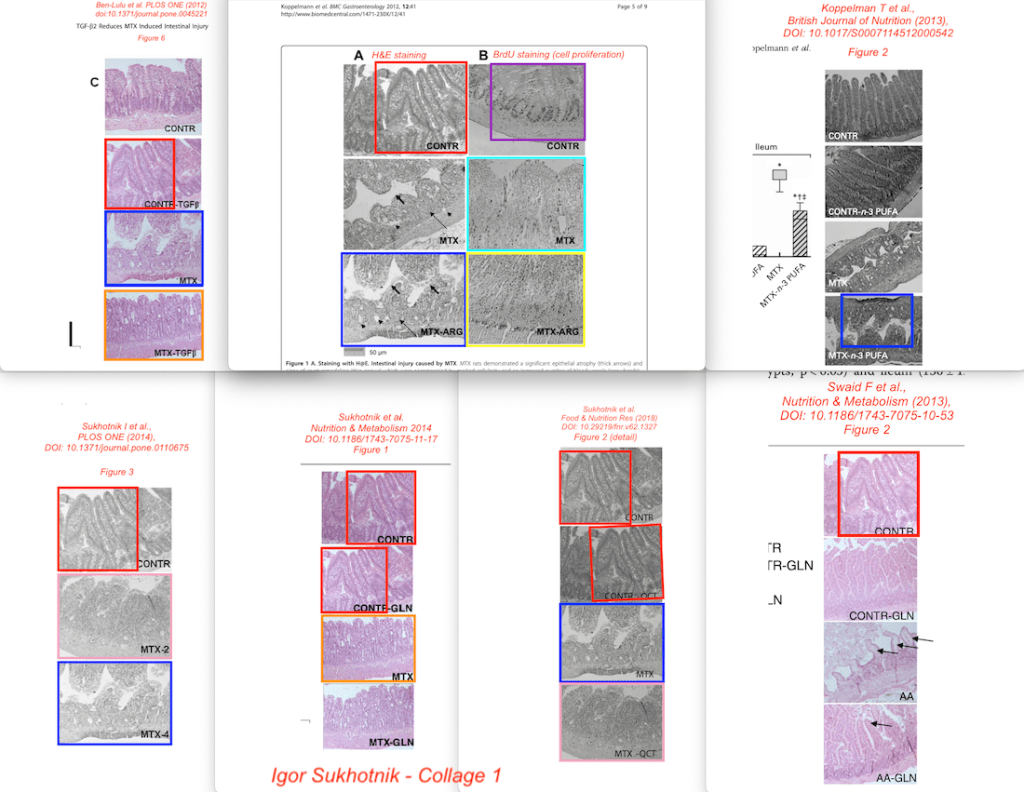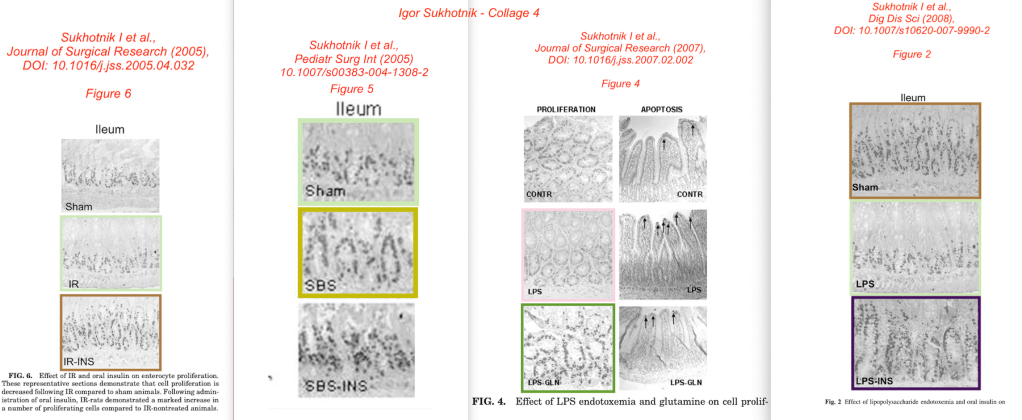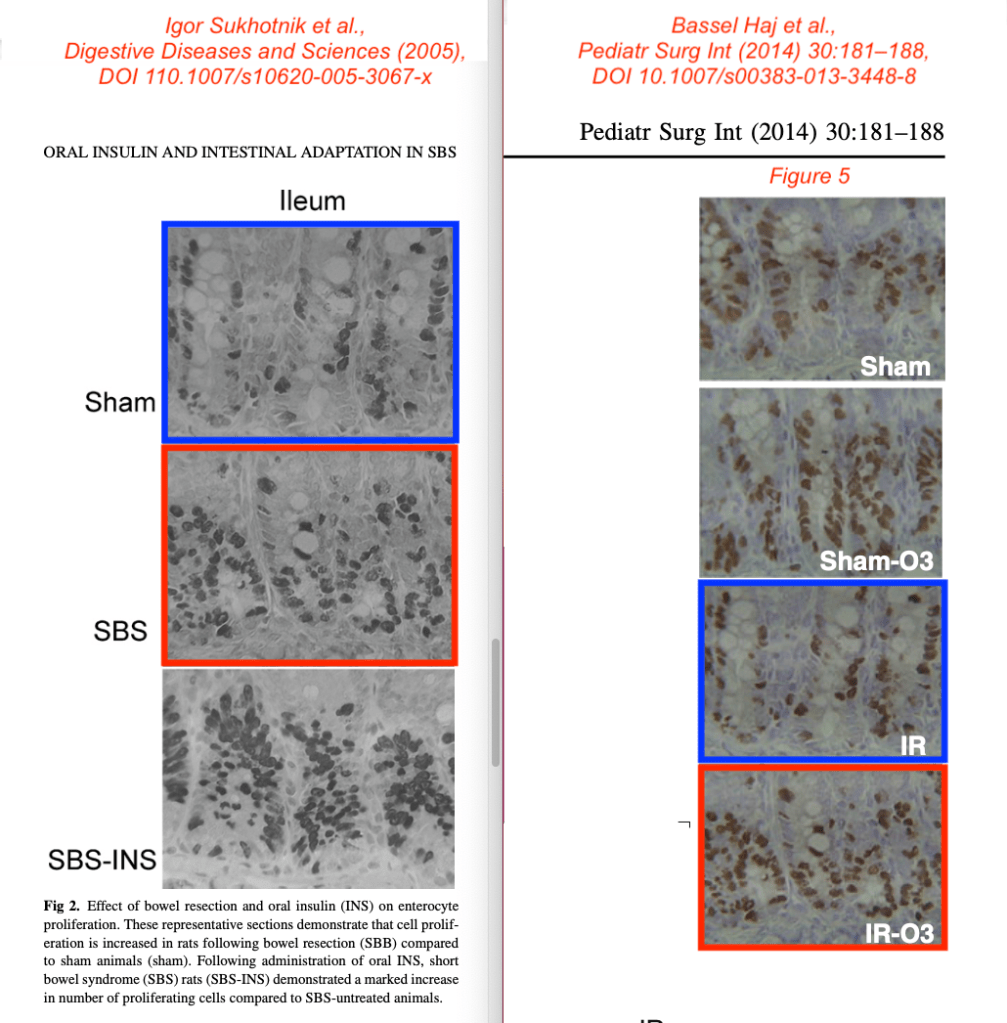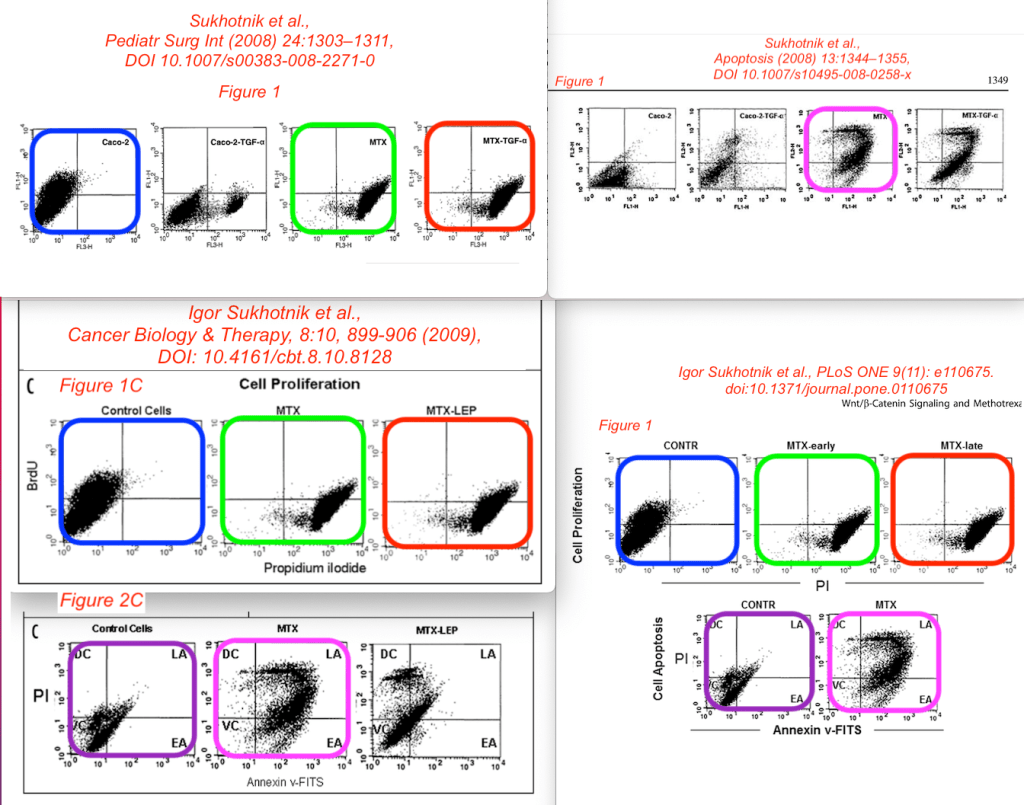The Technion-Israel Institute of Technology is the oldest university in Israel, ranking itself ‘among the world’s top science and technology research universities’.
It is here that a group of researchers appears to have been publishing remarkably similar photos for the last decade — or more.

This blog post is not an accusation of scientific misconduct. I am just observing that highly similar photos appear to have been used in multiple papers from the same group, while the labels suggest these might have represented different experiments. I might be wrongly interpreting the labels. It is up to the institute and journals to investigate what happened.
The Technion’s main campus, Technion City, is located on Mount Carmel in Haifa, while its associated Ruth and Bruce Rappaport Faculty of Medicine is located off-campus, close to the sea.
The Rappaport Faculty of Medicine website features an article about a “rapid non-invasive test for COVID-19” with a photo of some PCR tubes that is hopefully just a poorly chosen stock photo rather than a representative illustration of the campus staff’s pipetting techniques with infectious samples.

A research group on Short Bowel Syndrome
A group of researchers at the Rappaport Faculty of Medicine headed by Professor Igor Sukhotnik has been studying Short Bowel Syndrome, a disease that can occur after removal of part of the small intestine, such as in adult patients with Crohn’s disease or in young children with necrotising enterocolitis.
Since his appointment in 1988, Sukhotnik, an associate professor in Pediatric Surgery, appears to have advised only two masters students and no graduate students. However, his group has been reasonably prolific in writing research papers, with 127 papers indexed in PubMed.
But now 39 of Sukhotnik’s 118 research papers have been flagged on PubPeer for image and conflict-of-interest concerns.
Earlier work: Three papers from 2002
In 2002 Sukhotnik published three papers that all appear to use remarkably similar immunohistochemistry images of rat bowels. In the collage below, boxes of the same color highlight areas in microscopy panels that look much more similar to each other than expected. According to the labels, these images do not always represent the same experiments, in particular the region marked with an orange box. In one paper it represents the “sham” animal (a rat that underwent a mock surgery where the wound was closed without doing anything), while in other papers it represents a rat treated with SBS-SND, or LPS, respectively. The area marked with a green or blue box might represent the same animal, although it would not be good practice to have the same animal serve as the control for different experiments.
The three papers from this set are:
- Sukhotnik I et al., Digestive Diseases and Sciences (2002), DOI: 10.1023/a:1019641416671
- Sukhotnik I et al., Journal of Surgical Research (2002), DOI: 10.1006/jsre.2002.6556
- Sukhotnik I et al., Pediatr Surg Int (2002), DOI: 10.1007/s00383-002-0862-8

Image similarities between 18 papers spanning 14 years
One set of 18 papers from the Sukhotnik research group, published between 2005 and 2019, is noteworthy because all appear to show photos of rat gut tissues that are remarkably similar. The photos do not always represent the same animal experiments, though.
Here is the list of these 18 papers:
- Sukhotnik I et al., Pediatr Surg Int (2005) 21: 132–137, DOI: 10.1007/s00383-004-1308-2
- Sukhotnik I et al., Journal of Surgical Research (2005), DOI: 10.1016/j.jss.2005.04.032
- Sukhotnik I et al., Journal of Surgical Research (2007), DOI: 10.1016/j.jss.2007.02.002
- Mogilner JG et al., Journal of Pediatric Surgery (2007), DOI: 10.1016/j.jpedsurg.2007.03.035
- Sukhotnik I et al., Dig Dis Sci (2008), DOI: 10.1007/s10620-007-9990-2
- Sukhotnik I et al., Cancer Biology & Therapy (2009), DOI: 10.4161/cbt.8.10.8128
- Sukhotnik I et al., Journal of Pediatric Surgery (2011), DOI: 10.1016/j.jpedsurg.2010.09.051
- Ben-Lulu S et al., PLOS ONE (2012), DOI: 10.1371/journal.pone.0045221
- Koppelman T et al., BMC Gastroenterology (2012), DOI: 10.1186/1471-230X-12-41
- Koppelman T et al., British Journal of Nutrition (2013), DOI: 10.1017/S0007114512000542
- Swaid F et al., Nutrition & Metabolism (2013), DOI: 10.1186/1743-7075-10-53
- Sukhotnik I et al., Nutrition & Metabolism (2014), DOI: 10.1186/1743-7075-11-17
- Sukhotnik I et al., PLOS ONE (2014), DOI: 10.1371/journal.pone.0110675
- Sukhotnik I et al., European Journal of Pediatric Surgery (2016), DOI: 10.1055/s-0036-1587588
- Ben Shahar Y et al., European Journal of Pediatric Surgery (2016), DOI: 10.1055/s-0035-1559886
- Sukhotnik I et al., Pediatric Surgery International (2016), DOI: 10.1007/s00383-016-3979-x
- Sukhotnik I et al., Food Nutrition Research (2018), DOI: 10.29219/fnr.v62.1327
- Ben-Shahar Y et al., European Journal of Pediatric Surgery (2019), DOI: 10.1055/s-0039-1700550
Here are four collages with figures from these papers, in which I marked the images that look remarkably similar with boxes of the same color.




A triplet of papers from 2007-2019
Three other papers appear to form a triplet, with two very similar sets of panels appearing over a period of 12 years. These are shown in the collage below with blue and red boxes.
- Sukhotnik I et al., Pediatr Surg Int (2007), DOI: 10.1007/s00383-006-1863-9
- Sukhotnik I et al., Digestive Diseases and Sciences (2007), DOI: 10.1007/s10620-006-9629-8
- Ben‐Shahar Y et al., Pediatric Surgery International (2019), DOI: 10.1007/s00383-018-4406-2

Three papers from 2005, 2014, and 2016.
Another set of three papers also appear to show very similar images.
- Sukhotnik I et al., Digestive Diseases and Sciences (2005), DOI: 10.1007/s10620-005-3067-x
- Bassel Haj et al., Pediatr Surg Int (2014) 30:181–183, DOI: 10.1007/s00383-013-3448-8
- Sukhotnik I et al., Pediatr Surg Int (2016), DOI: 10.1007/s00383-016-3969-z

Western blots from four papers
A set of four papers, spanning 2012-2013, all appear to show remarkably similar ERK2 blots, but represent different experiments (marked in red below). Another blot also seems to make multiple appearances (marked with blue).
The four papers are:
- Ben-Lulu S et al., PLOS ONE (2012), DOI: 10.1371/journal.pone.0045221
- Sukhotnik I et al., Pediatr Surg Int (2013), DOI: 10.1007/s00383-012-3197-0
- Koppelman T et al., BMC Gastroenterology (2012), DOI: 10.1186/1471-230X-12-41
- Koppelman T et al., British Journal of Nutrition (2013), DOI: 10.1017/S0007114512000542
Here is a collage of the four figures, one from each of these papers.

Four papers with flow cytometry figures, 2008-2014.
A set of four papers, all by Sukhotnik et al., appear to contain highly similar flow cytometry panels. Boxes of the same color highlight panels that look very similar. They do not all appear to show the same experiment, in particular the panels labeled with red boxes.
The four papers span a period of six years and are:
- Sukhotnik et al., Apoptosis (2008) 13:1344–1355, DOI: 10.1007/s10495-008-0258-x
- Sukhotnik et al., Pediatr Surg Int (2008) 24:1303–1311, DOI: 10.1007/s00383-008-2271-0
- Sukhotnik et al., Cancer Biology & Therapy (2009), DOI: 10.4161/cbt.8.10.8128
- Sukhotnik et al., PLOS ONE (2014), DOI: 10.1371/journal.pone.0110675

Potential conflicts of interest
The group Sukhotnik et al. also filed a US Provisional Patent Application on June 2, 2004. This provisional, No. 60/575,803, was replaced a year later by PCT Patent Application No. PCT/IL2005/000587, filed on June 2, 2005. In 2011 this was finally granted as Patent US8026211B2.
The invention includes the following wording:
“A method for increasing intestinal function is provided. The method comprising orally and/or enterally administering to a subject in need thereof a therapeutically effective amount of insulin, thereby increasing intestinal function (…) The present invention relates to methods and formulations for increasing intestinal function, which may be used for treating short bowel syndrome.“
Despite filing the patent provisional in 2004, several papers from this group that report on insulin treatment of short bowel syndrome, or (induced) animal models of SBS, do not mention this pending patent at all. However, it is customary to disclose such potential conflict of interest somewhere in the paper. I could find no such statements in the Sukhotnik papers.
Some examples of papers that appear to be highly relevant to the methods described in this patent, all submitted after the provisional was filed, are:
- Sukhotnik I et al., Journal of Surgical Research (2005), DOI: 10.1016/j.jss.2005.04.032
- Sukhotnik I et al., Pediatr Surg Int (2005) 21: 132–137, DOI: 10.1007/s00383-004-1308-2
- Sukhotnik I et al., Dig Dis Sci (2008), DOI: 10.1007/s10620-007-9990-2
- Sukhotnik I et al., Pediatr Surg Int (2010), DOI: 10.1007/s00383-009-2520-x
- Ben Lulu S et al., Pediatr Surg Int (2012), DOI: 10.1007/s00383-011-2991-4
Reporting and follow up
As always, I will report my concern about this set of almost 40 papers to the journal editors and institution.

I believe this paper really represent position of Nature for this fabricated data
Too much reliance on anonymous tip-offs
Gilberto Corbellini
Nature volume 495, page449(2013)Cite this article
208 Accesses
10 Altmetric
Metricsdetails
Several scientific journals and ethics committees are deferring to anonymous judgment when it comes to charges of plagiarism and falsification of results in published research papers. As a bioethicist, I believe that this practice is risky, even when the tipster’s views are valid: it could itself damage the integrity of scientific research.
The authors of the blog Retraction Watch (www.retractionwatch.com) hold the view that anomalies detected by someone using the pseudonym ‘Clare Francis’ are useful to scientific journals, irrespective of his or her anonymity (see A. Marcus and I. Oransky Lab Times 7, 39; 2011). But this unorthodox ‘review’ process pollutes the ethics that underpin scientific progress.
The practice could stimulate witch-hunting and pillorying. There is a danger that research-integrity committees could succumb to moralistic drift and confuse errors with misdeeds, underestimating context and a scientist’s professional record. Stigmatized researchers might be tempted to exact revenge on their colleagues.
In my opinion, this is not the way to improve the moral standards of science’s contribution to society or to build public engagement in science.
LikeLike
The following questions may be asked for your group:
1/Can you provide your personal information including real name, e-mail, phone number, position, research experience.
2/What is purpose of your activity? If the purpose is an improving scientific process, please provide concrete concerns about this research? Did you read the manuscript?
3/Do you have any financial interest for your “review” process? Did you declare this statement.
4/Did you sign any conflict of interest form?
5/ Is your activity legal. Did you receive permission from author to publish his pictures in Internet?
6/Does your activity is supported by any journal to decrease selected journal impact factor?
LikeLike
https://pubpeer.com/publications/F191BC9A4E84DEAE30D29F9B1D335B#4
May 19, 2021
“Retraction Note to: Pediatr Surg Int (2003) 19(5):385–390 https://doi.org/10.1007/s00383-003-1016-3 The Editors-in-Chief have retracted this article because parts of Fig. 1 apparently overlap with parts of Fig. 2, and in addition parts of Fig. 1 appear to be duplicated from parts of Fig. 2 in a previously published article [1]. Author Igor Sukhotnik does not agree to this retraction. Authors A. Semih Gork, Min Chen, Robert A. Drongowski, Arnold G. Coran, and Carroll M. Harmon have not responded to any correspondence from the publisher about this retraction.”
LikeLike
@Sukhotnik I, MD: Is that your defense?
Why not just explain the totally coincidentally same looking pictures? You are a real scientist right?
So it should be really childsplay to present lab-book entries and the like for all those pictures used, right? This is just called good scientific practise. That your defense rest not on your raw-data, hurts your case the most in my eyes.
Instead you go into strange legal detours, about the legality of open-source-journalism. Someone has actually read your PUBLISHED papers. Clearly its legal to now report about said public information.
LikeLike